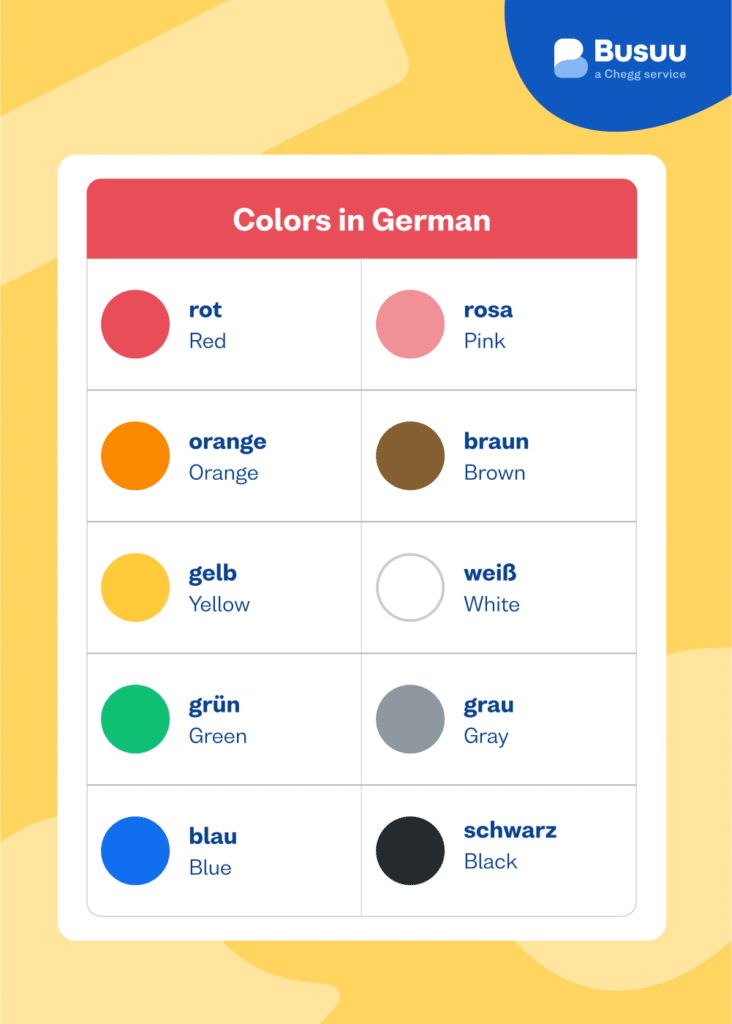Home » Colors in German: Learn and pronounce all the popular colors
What color is used to describe someone who is drunk in German, perhaps at Oktoberfest?
What color is associated with someone who rides the train without buying a ticket?
What is the most popular car color in Germany?
We’ll answer all these questions and more in this cheat sheet to colors in German!
Colors are a universal language, which makes them an important topic to learn when traveling in German speaking countries.
This article will teach you the 14 most popular German colors, with audio recordings to guide your German pronunciation, and popular idioms you may hear when you learn German.
Learn how to answer the question “So… Was ist deine Lieblingsfarbe?” (What is your favorite color?) and tell your preferred color in German with Busuu’s free courses and online learning resources!
Here are the most common German colors and their translation (with audio). It’s important to remember, if you are using color to describe something, the color will normally come before the noun. Der rote Apfel – the red apple.

If you’re a wine drinker, rot is an important color to learn.
Red wine is Rotwein in German. The Spätburgunder is a Pinot Noir, a popular red wine variety grown in all 13 wine regions throughout Germany.
Luckily for English speakers, orange in German has the same spelling as in English, with only a slight difference in pronunciation. Listen for the raspy ‘r’ sound in German.
In German, both the color and the fruit are orange – but the fruit must be capitalised when written, as it’s a noun.
Be careful, gelb – yellow in German – is one of those tricky false friends. It can easily be mistaken for the English color gold.
Fun fact: The color gold is the same word in both English and German!
And while sunny yellow is a color associated with optimism and hope, Germans actually say they are yellow with envy: Gelb vor Neid – whereas in English, we would say we are green with envy.
Nature-loving Germans are often said to have a green thumb: einen grünen Daumen.
As in many countries, green in German – grün – features in the name of a ‘green-focused’ German political party: Die Grüne.
Their focus is on protecting the environment. Germany is a world leader in sustainability, renewable energy, recycling and public transport.
After a few German beers at Oktoberfest, you might be described as blau sein – literally, to be blue.
But in this context, this expression using blau – blue in German – means something entirely different. Here, it means to be drunk.
And the next day, if you are feeling hungover, you may “blau machen” (take a cheeky day off work).
As you drink your morning coffee, you may see a beautiful hellblau himmel, or light blue sky.
From fashion to home decor, dunkelblau is an elegant color that has a down-to-earth quality and symbolises relaxation, balance and harmony.
Throughout Germany in Autumn, lilafelden, or purple fields, spread across the countryside. These lila colored flowers are called Phacelia, and are planted after the grain harvest to restore nutrients in the soil.
Thinking of a rose is a simple way to remember the German word for pink, rosa.
The expression Durch die rosa Brille schauen, lo look through pink glasses, means you have an overly optimistic outlook on things.
The color khaki is the same in both English and German, and refers to both the beige color, as well as the style of pants popular for outdoor sports such as hiking.
It’s highly likely you’ll meet a Frau Schwarz on a visit to German-speaking countries, as it’s one of the most popular German surnames.
And if you travel to Germany, don’t be a Schwarzfahrer – a cheeky rule-bender who rides the train without buying a ticket!
Another popular last name, white in German is weiß, featuring the German letter ß, which is pronounced like a double-s.
Why do Autobahns in Germany may look a bit bland? Because grau is officially the most popular car color in Germany, according to Statista.
The popular expression “Nachts sind alle Katzen grau”, meaning all cats are gray in the night, is another way to say everything looks alike.
Although it’s spelled slightly differently, the pronunciation of braun in German and English is very similar.
But it’s also used when someone returns from their summer holiday with a dark tan.
“Du bist aber braun geworden!” (You’ve got a nice tan!)
Use these common adjectives to further describe colors in German. They should always be used before the color that they refer to in written and spoken German.
You can use hell in front of any color to modify it as a light color. When written, there is no space between the two words, so light green would be hellgrün.
Add dunkel before a color to emphasise the level of darkness. Dunkel is also a variety of German beers, typically ranging in color from amber to dark brown: dunkelbraun.
Matt is used to describe surfaces such as walls or car colors that are dull in appearance.
A garden full of tulips in spring, or the fresh produce at a market stall on the weekend might be described as bunt.
With Busuu’s free online courses and learning resources, you can add color to your world and be able to learn and speak more words and vocabulary in German!
We think you might also like…